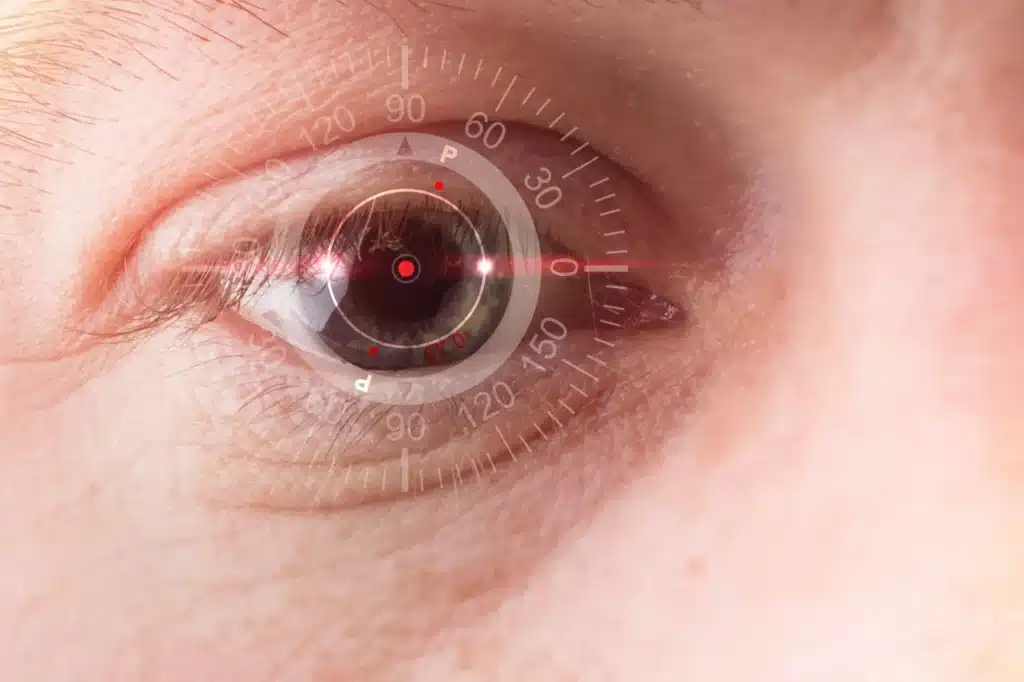The cornea is the clear and transparent connective tissue that makes up the front surface of the eye – it’s a lot like the windshield of your vehicle or the face on your watch. While it’s known for protecting the eye from dirt, germs, bacteria, and debris, it’s also responsible for a majority of the refractive power of the eye.
There are six primary layers that make up the cornea:
- Epithelium – the outermost anterior layer of the cornea, which is responsible for barrier function and ensuring the tear film has a smooth surface to work on.
- Bowman’s Membrane – the smooth, acellular, non-regenerating corneal layer that’s primarily made up of collagen, which provides toughness and stability.
- Dua’s Layer – the thinnest layer of the cornea and the one most recently discovered, meaning it’s rather new to the scientific world.
- Stroma – makes up nearly 90% of the cornea’s structure and is primarily made up of collagen fibers and keratocytes, which strengthen the cornea and help it maintain shape.
- Descemet’s Membrane – a basement membrane that helps anchor the endothelium to the cornea, which is essential for nutrient transfer and endothelial cell health.
- Endothelium – a monolayer of cells responsible for transporting water into the anterior chamber from the stroma, ensuring the cornea remains wet and transparent.
Being avascular, the cornea is void of blood vessels and, therefore, has no direct blood supply. Instead, the cornea gets most of its nutrients from the aqueous humor. The cornea needs those nutrients in order to function properly, but it also needs to have the proper shape and has to be clear and transparent.

What is Corneal Transplant Surgery?
Corneal transplant surgery, also known as keratoplasty, is a procedure designed to repair damage to the front surface of the eye (cornea). The process involves replacing the eye’s diseased cornea (or at least part of it) with a healthy cornea from a cadaver donor. The results are often life-changing for the patient(s).
Most people who require a corneal transplantation are suffering from a condition called keratoconus – which occurs when the cornea weakens, thins, and eventually changes shape. Thinning of the cornea is most common among elderly patients, while an abnormally-shaped cornea is more common in young adults.
Other reasons why someone might need a corneal transplant include corneal dystrophy, corneal scarring, corneal swelling, eye trauma, eye injury, complications from previous eye surgery, and keratitis. There are three primary types of corneal transplant surgery – let’s take a look at the differences between each one.
1. Penetrating Keratoplasty (PK)
Penetrating keratoplasty (PK), also known as full thickness corneal transplant, is designed to replace the entire cornea (both the front and inner layers). There is an increased risk of corneal rejection after the donor cornea is inserted and vision might take up to a year to improve, but the outcome is well-worth it.
2. Deep Anterior Lamellar Keratoplasty (DALK)
Deep anterior lamellar keratoplasty (DALK), also referred to as partial thickness corneal transplant, is when the middle and front layers are removed and replaced, but the innermost layer (endothelial layer) is left alone. It’s a common surgery for those suffering from keratoconus – when the cornea bulges outward.
3. Endothelial Keratoplasty
Endothelial keratoplasty is when the innermost layer of the cornea is removed and replaced with healthy donor cornea tissue. When damaged, the cornea will begin to swell up and make it difficult to see clearly. DSEK and DMEK are two of the most prominent types of endothelial keratoplasty procedures used today.
4. Keratoprosthesis
Keratoprosthesis is more of a ‘plan B’ when it comes to corneal transplant surgery. During the procedure, the natural cornea is removed and replaced with an artificial cornea – opposed to a donor cornea. It’s usually necessary when the damaged or diseased cornea is too far gone or when a cornea transplant fails.
What to Expect From Cornea Transplant Surgery
Before you start the procedure, your doctor will run you through what to expect from the surgery – why you need it, how it can help, and what the procedure involves. In the days leading up to the surgery, you’ll be asked to stop taking certain medications and may be asked to take a physical exam to analyze health.
Corneal transplant surgery is an outpatient procedure, which means it’s completed in the doctor’s office.
You’ll be given eye drops, local or general anesthesia, and other medication if needed. The eye is hooked up to a speculum, which helps keep the eyes open during surgery – you’ll barely see or feel anything.
After the surgery, which takes roughly 1-2 hours, your doctor will give you a set of aftercare guidelines to follow. You’ll be asked to use eye drops, avoid rubbing the eye, wear protective eyewear, sunglasses, and an eye shield when necessary, and make temporary changes to your normal day-to-day routine.
How to Become a Cornea Donor
Cornea transplants aren’t possible without the help of corneal donors – individuals who have passed away and had their corneas (and other organs) donated. Since blood type doesn’t have to match when replacing a diseased or damaged cornea with healthy donor tissue, almost anyone can be a corneal donor.
With more than 85,000 corneal transplants taking place in the United States every single year, eye banks across the country are always in need of donor cornea – keep in mind, every donor can restore sight to two people. If you’d like to become a cornea donor, register as one through your local Donate Life office.
Learn More at Milwaukee Eye Surgeons
The cornea is one of the most important structures in the eye – often viewed as the ‘window to the eye.’ It not only protects the rest of the eye from the elements we’re exposed to on a daily basis, but it provides more than two-thirds of the refraction power – functional eyesight simply wouldn’t be possible without it.
For that reason, any damage to the cornea must be addressed immediately – that’s where we come in. At Milwaukee Eye Surgeons, we not only pride ourselves in helping to diagnose, treat, and repair corneal damage, but we take pride in detecting corneal issues early on – allowing for swift and precise treatment.
Contact us today to schedule an appointment with Dr. Kenneth Weinlander – we can’t wait to help you take better control of your eye health!





